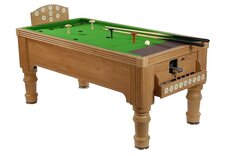The Rules of Rings or ringboard
The game of rings is not particularly well-known but has been popular both as a children's game and as a pub game - particularly in Ireland. When in any doubt, the rules played by the locals should always apply. Please note that 1 yard = 3 feet = 36 inches = 0.9144 metres.
See also: Rings.
Description
A Ring board is usually a shield shaped board with a number of hooks on it, each one clearly marked with a number to indicate the scoring value. The most common number of hooks seems to be 13 and each hook scores one of the numbers 1 - 13. In the manner of a dart board, the numbers never go sequentially but tend to be spread fairly randomly but the three highest numbers are always positioned on the middle row with the highest number in the middle. Here is the layout of a typical board.
Layout from an early 20th Century Ringboard
- 9, 5, 10
- 3, 2
- 11, 13, 12
- 7, 1, 4, 6
- 8
World Ringboard Academy layout
- 10, 2, 9
- 5, 6
- 11, 13, 12
- 4, 3
- 7, 1, 8
- Up to and including 9 years: 5` 6" / 168cm
- Up to and including 11 years: 6` 6" / 198cm
- Up to and including 15 years: 7` 6" / 229cm
- 16 years and above: 8` 6" / 259cm
121 Up
The most common type of game played on a ring board is, like Darts, a simple scoring game, the first to the target score winning. The target score has to be achieved exactly although not necessarily with the final ring of the turn. The most common game seems to be 121 up - this is possibly because it is easy to score this on a cribbage board, which would often be used for the purpose.
One variant of the game has it that 3 consecutive rings around the same number in a turn wins the game outright. Presumably this maintains interest in a game where one player roves far ahead into the lead.
World Ringboard Academy Rules
Basics
The game is usually played to a pre-agreed total + 4 No. 1s. For a friendly game, the pre-agreed total is usually 150 or 200 for singles and 200 or 250 for doubles. The game is sometimes played competitively to 300 or 400. Players take turns to throw six rings at the board; their total score is being recorded each time.
The Nomination Number
As soon as a player needs 13 or less to reach the pre-agreed total, the amount required becomes that player's "nomination number". The player's next scoring ring must land on their nomination number and if a ring lands on any other number, the player's turn finishes immediately (this is called 'hanging up').
The Four No.1s
Once the player has reached the pre-agreed total by landing on their nomination number, their final task is to score 4 rings on the No. 1 hook. As with the nomination number, while trying for the No.1s, if a ring lands on any other number, that ring does not score and the players turn comes to an end immediately (the player 'hangs up').
The first player to reach the pre-agreed total with their nomination number and then land 4 rings on the No.1 hook wins the game.
Around the Clock
Other games often played on a ringboard are based on the "clock" principle of trying to throw a ring on each number in sequence starting with 1 and ending with 13.
The game played in Lancashire is a good example of this to try. Players must go "around the clock" twice, but crucially "doubles" count. A double is 2 consecutive rings on the target hook and enable the player to skip the interim numbers. For instance, suppose a player is aiming for 5. When he achieves this, he would normally throw at 6 with the next ring. However, assuming that wasn't the final ring of the turn, if the next ring lands on a 5 too, this is counted as a double which scores 10. His next target would then be 11.
Thirty One
The final game listed here was known to have been played in Kirkhampton, Cumbria during the latter half of the twentieth century. The aim of the game is simple - to score 31 exactly using 5 rings. Players take turns to achieve this feat and the first one to do so, wins.
These rules are provided by Masters Traditional Games, an Internet shop selling quality traditional games, pub games and unusual games. For general information or for copying and copyright, see our Rules Information page.
Our rules are comprehensive instructions for friendly play. If in doubt, always abide by locally-played or house rules.
Copyright James Masters, 2025. All rights reserved.


























